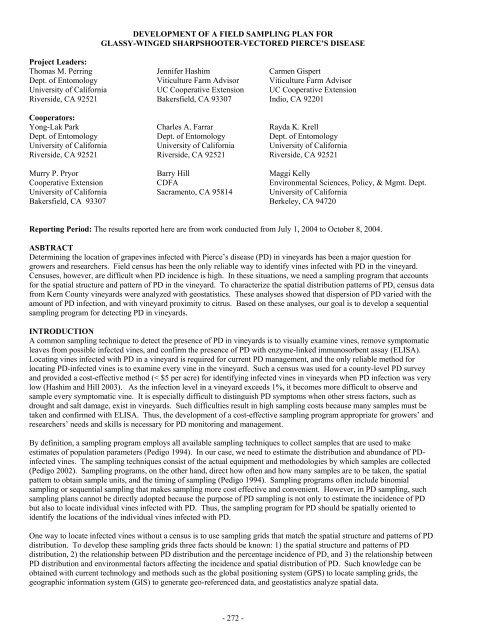Impact Of Host Plant Xylem Fluid On Xylella Fastidiosa Multiplication ...
Impact Of Host Plant Xylem Fluid On Xylella Fastidiosa Multiplication ...
Impact Of Host Plant Xylem Fluid On Xylella Fastidiosa Multiplication ...
Create successful ePaper yourself
Turn your PDF publications into a flip-book with our unique Google optimized e-Paper software.
DEVELOPMENT OF A FIELD SAMPLING PLAN FOR<br />
GLASSY-WINGED SHARPSHOOTER-VECTORED PIERCE’S DISEASE<br />
Project Leaders:<br />
Thomas M. Perring<br />
Dept. of Entomology<br />
University of California<br />
Riverside, CA 92521<br />
Cooperators:<br />
Yong-Lak Park<br />
Dept. of Entomology<br />
University of California<br />
Riverside, CA 92521<br />
Murry P. Pryor<br />
Cooperative Extension<br />
University of California<br />
Bakersfield, CA 93307<br />
Jennifer Hashim<br />
Viticulture Farm Advisor<br />
UC Cooperative Extension<br />
Bakersfield, CA 93307<br />
Charles A. Farrar<br />
Dept. of Entomology<br />
University of California<br />
Riverside, CA 92521<br />
Barry Hill<br />
CDFA<br />
Sacramento, CA 95814<br />
Carmen Gispert<br />
Viticulture Farm Advisor<br />
UC Cooperative Extension<br />
Indio, CA 92201<br />
Rayda K. Krell<br />
Dept. of Entomology<br />
University of California<br />
Riverside, CA 92521<br />
Maggi Kelly<br />
Environmental Sciences, Policy, & Mgmt. Dept.<br />
University of California<br />
Berkeley, CA 94720<br />
Reporting Period: The results reported here are from work conducted from July 1, 2004 to October 8, 2004.<br />
ASBTRACT<br />
Determining the location of grapevines infected with Pierce’s disease (PD) in vineyards has been a major question for<br />
growers and researchers. Field census has been the only reliable way to identify vines infected with PD in the vineyard.<br />
Censuses, however, are difficult when PD incidence is high. In these situations, we need a sampling program that accounts<br />
for the spatial structure and pattern of PD in the vineyard. To characterize the spatial distribution patterns of PD, census data<br />
from Kern County vineyards were analyzed with geostatistics. These analyses showed that dispersion of PD varied with the<br />
amount of PD infection, and with vineyard proximity to citrus. Based on these analyses, our goal is to develop a sequential<br />
sampling program for detecting PD in vineyards.<br />
INTRODUCTION<br />
A common sampling technique to detect the presence of PD in vineyards is to visually examine vines, remove symptomatic<br />
leaves from possible infected vines, and confirm the presence of PD with enzyme-linked immunosorbent assay (ELISA).<br />
Locating vines infected with PD in a vineyard is required for current PD management, and the only reliable method for<br />
locating PD-infected vines is to examine every vine in the vineyard. Such a census was used for a county-level PD survey<br />
and provided a cost-effective method (< $5 per acre) for identifying infected vines in vineyards when PD infection was very<br />
low (Hashim and Hill 2003). As the infection level in a vineyard exceeds 1%, it becomes more difficult to observe and<br />
sample every symptomatic vine. It is especially difficult to distinguish PD symptoms when other stress factors, such as<br />
drought and salt damage, exist in vineyards. Such difficulties result in high sampling costs because many samples must be<br />
taken and confirmed with ELISA. Thus, the development of a cost-effective sampling program appropriate for growers’ and<br />
researchers’ needs and skills is necessary for PD monitoring and management.<br />
By definition, a sampling program employs all available sampling techniques to collect samples that are used to make<br />
estimates of population parameters (Pedigo 1994). In our case, we need to estimate the distribution and abundance of PDinfected<br />
vines. The sampling techniques consist of the actual equipment and methodologies by which samples are collected<br />
(Pedigo 2002). Sampling programs, on the other hand, direct how often and how many samples are to be taken, the spatial<br />
pattern to obtain sample units, and the timing of sampling (Pedigo 1994). Sampling programs often include binomial<br />
sampling or sequential sampling that makes sampling more cost effective and convenient. However, in PD sampling, such<br />
sampling plans cannot be directly adopted because the purpose of PD sampling is not only to estimate the incidence of PD<br />
but also to locate individual vines infected with PD. Thus, the sampling program for PD should be spatially oriented to<br />
identify the locations of the individual vines infected with PD.<br />
<strong>On</strong>e way to locate infected vines without a census is to use sampling grids that match the spatial structure and patterns of PD<br />
distribution. To develop these sampling grids three facts should be known: 1) the spatial structure and patterns of PD<br />
distribution, 2) the relationship between PD distribution and the percentage incidence of PD, and 3) the relationship between<br />
PD distribution and environmental factors affecting the incidence and spatial distribution of PD. Such knowledge can be<br />
obtained with current technology and methods such as the global positioning system (GPS) to locate sampling grids, the<br />
geographic information system (GIS) to generate geo-referenced data, and geostatistics analyze spatial data.<br />
- 272 -











